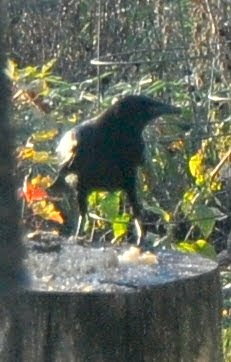
Chris the male Crow grabs some pineapple covered in rather dry rice off the goodie stump.

He then flies over to the bird bath and places it in the water to rehydrate. (I love it when Crows "cook"!)
That is the beginning of a long sequence of action, but there is lots of news so instead of waiting another day to put up the news in order to get the whole sequence of photos up tonight, above is the intro to the beginning so you can get the gist. Then we'll do news and you can continue on down for the end. Think of it as a Neil Gaiman novel because most of the beginning will be posted in another blog.
Sometimes stuff happens, the best laid plans...
NOW TO THE NEWS--
First up, a Symposium--WILD NYC, 11/ 18, that's this coming Thursday, for those within reach of the City, from 3:30 to 6:00pm, in the Gallatin's main event space on the first floor of 1 Washington Place, corner of B'way and Washington Place between Waverly and 4th.
Participants who will speak and take part in a panel discussion plus a Q& A with the audience include Linda Couturier, author of The Hopes of Snakes, Meredith Comi who is the director of the NY/NJ Baykeeper's Oyster Restoration Program, yours truly talking about our love affair with Red-tailed hawks, and Chris Nadereski, (who works with Peregrine Falcons and other raptors), will be bringing his birds with him.
NEXT--Word in from Nara M., who's living room abutts a favorite roost fire escape of Isolde and Norman of Morningside Park and the St. John the Divine Nest--Hi Donna,
Tonight they're back, with a slightly different sleeping arrangement: one is on the railing, like last night, and the other is perched on top of the a.c. unit in the next window over! (it's mounted on the top of the window, so we can just see some tail feathers hanging down). I just went to check what was going on as there's a clacking sound coming from the a.c.--not sure if it's the bird's claws or if the a.c. unit is settling under the weight.
Nara
And in from Robin of Illinois, a link to watch long time contributor to the blog, Sally of Kentucky, who does work with Raptor Rehabilitation of Kentucky on a KNET TV news magazine. Sally is in the last news segment of the program.
http://www.ket.org/cgi-bin/cheetah/watch_video.pl?nola=KLOUL+000503&altdir=&template
And from Janesville Eagle Watcher, Beakerless-- just saw the pair of bald eagles at the Racine Street bridge in Janesville. Both were fully mature and one was significantly larger than the other. They were again flying low over the river looking for fish. I haven't seen them through the summer months and was overjoyed to see them back again.
Now to the beginning of the end of Chris Crow, his mate, Carol and their yearling, Junior, who rather hilariously is the spitting image of Chris only he isn't yet full grown.
 At 4:28:28, (all times PM) Carol and Junior show up at the bird bath while Chris is over on the goodie stump selecting more pineapple segments. And here we have an excellent photo to go over some of the ways to tell a female crow from a male crow. Junior is on the left and Carol on the right. Compare their beaks.
At 4:28:28, (all times PM) Carol and Junior show up at the bird bath while Chris is over on the goodie stump selecting more pineapple segments. And here we have an excellent photo to go over some of the ways to tell a female crow from a male crow. Junior is on the left and Carol on the right. Compare their beaks. Even though Junior is still smaller than Carol, for the moment at least, his beak is definitely longer and chunkier than hers.
Also compare the tarsi. Junior appears far more long legged (just like Chris) than does Carol. And it isn't just because Carol appears to be pleasantly plump. (Hey, that Chris really knows how to rehydrate some tasty meals. )
Males also have longer tails though this isn't a good photo for that comparison.

Speaking of Carol and food, she leans down and selects a tidbit that Chris put in the bath earlier.

Chris is over on the stump selecting out more pineapple while Carol and Junior pause for a drink of water.

Crows, who like most birds, are not capable of the sucking action of pigeons and doves, fill their beaks with water and then lean their heads back so it runs down their throats.

Chris continues to go about his business even though he knows I'm there, though in the house a good distance away and behind glass, but Junior and Carol, having heard the camera, are now giving me the crow eyeball.

They don't relent.



Finally Junior takes off and Carol isn't far behind.

Chris carefully watches where they are going.

Still watching.

He makes sure I haven't crossed any boundaries while he was otherwise occupied.

He caws four times, with a little something in his mouth.

Eyeballs me.

And goes back to picking.

For whatever reason he seems to stare at the bits for several seconds before picking any of them up.


Gulp, and it's nearly gone.

He stares at the pile of food.

Stares some more.

Still staring.

Then picks up a pineapple segment.




4:29:59
A little hard to get down perhaps?

4:30:02 Choosing.

4:30:05 Big bite.

One of the other crows does a fly-by.

4:30:19 And Chris heads for the bird bath with his big bite and puts it in the water.

4:30:24 Watching the progress.

4:30:26 He pulls it out and tests it.

Might just be alright.

Is he looking for Carol and Junior?

4:30:41 Back in it goes.


4:30:47

4:30:48

4:30:50

4:30:51 And he's off.

4:38

5:05 And a snack for later.
Donegal Browne











